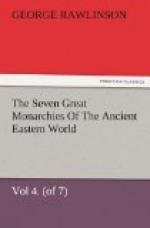We may conceive that some similar notion was entertained by the proud Babylonians, who no doubt regarded themselves as infinitely superior in manners and culture, no less than in scientific attainments, to the “barbarians” of Persia and Greece. While rage boiled in their hearts, and commands to torture and destroy fell from their tongues, etiquette may have required that the countenance should be unmoved, the eye serene, the voice low and gentle. Such contrasts are not uncommonly seen in the polite Mandarin, whose apparent calmness drives his European antagonist to despair; and it may well be that the Babylonians of the sixth and seventh centuries before our era had attained to an equal power of restraining the expression of feeling. But real gentleness, meekness, and placability were certainly not the attributes of a people who were so fierce in their wars and so cruel in their punishments.
CHAPTEE IV. THE CAPITAL.
Babylon, the capital of the Fourth Monarchy, was probably the largest and most magnificent city of the ancient world. A dim tradition current in the East gave, it is true, a greater extent, if not a greater splendor, to the metropolis of Assyria; but this tradition first appears in ages subsequent to the complete destruction of the more northern city; and it is contradicted by the testimony of facts. The walls of Nineveh have been completely traced, and indicate a city three miles in length, by less than a mile and a half in breadth, containing an area of about 1800 English acres. Of this area less than one tenth is occupied by ruins of any pretension. On the admitted site of Babylon striking masses of ruin cover a space considerably larger than that which at Nineveh constitutes the whole area of the town. Beyond this space in every direction, north, east, south and west, are detached mounds indicating the former existence of edifices of some size, while the intermediate ground between these mounds and the main ruins shows distinct traces of its having been built upon in former days.
Of the actual size of the town, modern research gives us no clear and definite notion. One explorer only has come away from the country with an idea that the general position of the detached mounds, by which the plain around Hillah is dotted, enables him to draw the lines of the ancient walls, and mark out the exact position of the city. But the very maps and plans which are put forward in support of this view show that it rests mainly on hypothesis; nor is complete confidence placed in the surveys on which the maps and plans have been constructed. The English surveys, which have been unfortunately lost, are said not to have placed the detached mounds in any such decided lines as M. Oppert believes them to occupy, and the general impression of the British officers who were employed on the service is that “no vestige of the walls of Babylon has been as yet discovered.” [Plate XI.]




